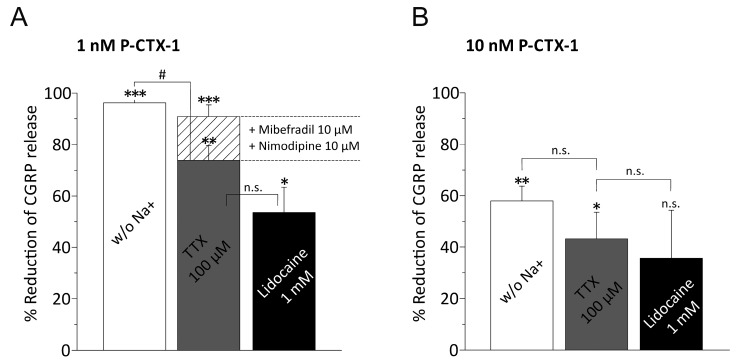Figure 3.
CGRP release by P-CTX-1 requires extracellular sodium via VGSCs activation and induces VGCC activation. The columns represent the reduction of the P-CTX-1-induced iCGRP release by extracellular solution deprived of sodium ions and the respective blockers TTX 100 µM or Lidocaine 1 mM in murine skin. The values were calculated from baseline subtracted iCGRP release in pg/mL as measured in incubation step 2 and represent a matched pair comparison where one skin side was treated with drug and the other served as matched control. Statistical comparisons were performed with the respective t-tests for paired groups (asterisks) or ANOVA (unpaired groups, hashtags where applicable). Significance is indicated with * or # for p < 0.05, ** for p < 0.01 and *** for p < 0.001; n.s. relates to no significant difference. (A) Percent reduction of iCGRP-release induced with 1 nM P-CTX-1. Sample sizes: sodium-free solution: n = 4 (matched pairs, p = 1.9 × 10−5); 100 µM TTX: 8 pairs (p = 0.001); 1 mM lidocaine: n = 4 pairs (p = 0.03). The matched-pair comparison of the reduction of P-CTX-1-induced CGRP-release by TTX 100 µM alone (grey column) and the combination of TTX 100 µM with T- and L-type VGCC blockers mibefradil 10 µM and nimodipine 10 µM is calculated as reduction of the residual iCGRP release after TTX-block and is superimposed and visualized as the bar filled with striped pattern. The residual iCGRP release after TTX-block is reduced by VGCC block by additional 17% (n = 14 matched pairs, p = 0.008, paired t-test). (B) Percent reduction of iCGRP-release induced with 10 nM P-CTX-1. Sample sizes: sodium-free solution: n = 11 (matched pairs, p = 0.002); 100 µM TTX: n = 6 (p = 0.047); 1 mM lidocaine: n = 10 (p = 0.06). Notably increasing concentrations of P-CTX-1 reduce the effect of both sodium channel block and deprivation of extracellular sodium (see text).

